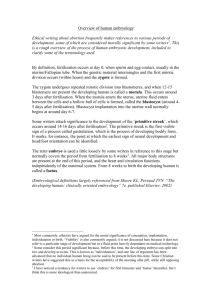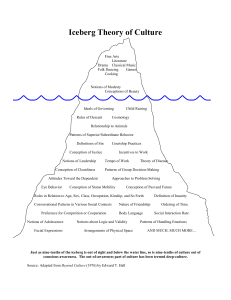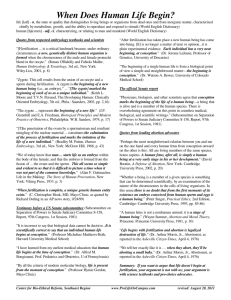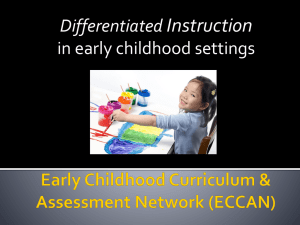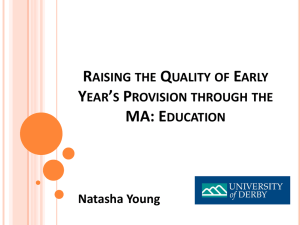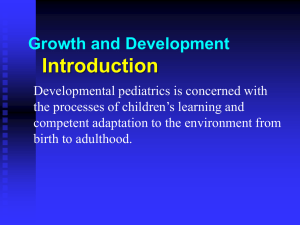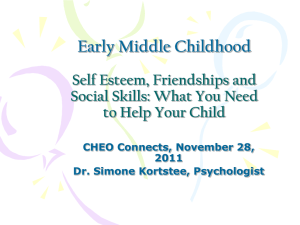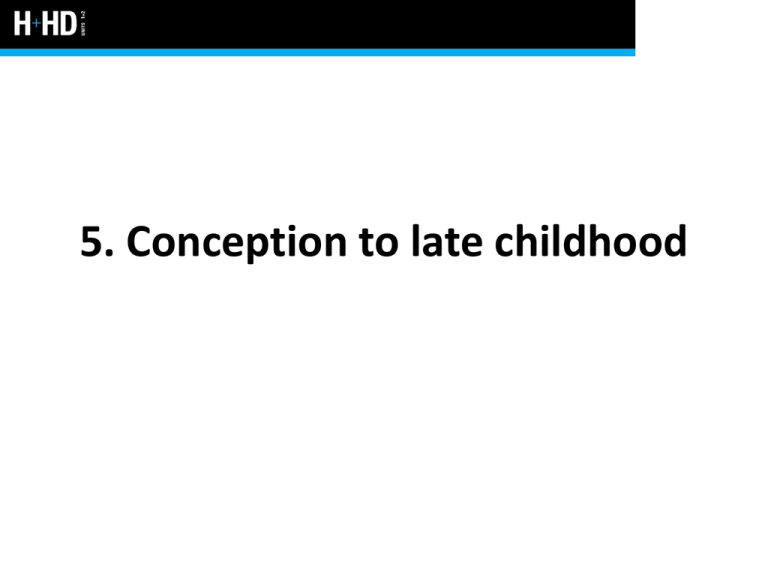
5. Conception to late childhood
Physical development from
conception to birth
• Physical changes that occur from conception
to birth involve a series of orderly and
predictable changes
• Infancy: (birth – 2 years)
• Early childhood: (2 – 3 years)
• Middle childhood: (3 – 6 years)
• Late childhood: (6 – 12 years)
Conception and fertilisation
• Human growth and development begins
occurring before birth
• A sperm cell is the male gamete
• An ovum is the female gamete
• Fertilisation occurs when a sperm penetrates
an ovum
• At fertilisation, the sex of the new individual is
determined
Prenatal development
• Germinal stage : starts at conception and ends
when the blastocyst implants on the uterine
wall
• Embryonic stage : lasts about 2 months after
conception
• Foetal stage: Continues until birth
Germinal stage
• The cell formed at conception is called a
zygote
• The zygote divides into two cells and
continues to divide rapidly until it forms a
solid ‘ball’ called a morula
• By about the fifth day, the organism is called a
blastocyst
• The blastocyst implants on the uterine wall
Embryonic stage
• Once implantation has occurred, the organism
is known as an embryo
• This period lasts for about 2 months and is
characterised by rapid growth and
development – the embryo develops the
structure and characteristics of a human being
• By the end of this stage, all major organs are
present and will continue to develop
Foetal stage
• Begins in the 9th week of pregnancy and
continues until birth (full term = 40 weeks)
• At this stage, the embryo is known as a foetus
• During this stage, the foetus grows from 5
centimetres long to approximately 50
centimetres long at birth
Physical changes from birth
• Neonate: the term used to describe a
newborn baby (birth – 4 weeks)
• Key adjustments after birth:
– Nutrition
– Circulation and respiration
– Temperature control
– Removal of body wastes
Physical changes during infancy
and childhood
• Physical growth and development
– Height
– Weight
– Changes to body proportions
– Changes in body composition
– Motor development
Social development
• Social development begins at birth when an
infant begins to interact with others
• Occurs in a number of ways, including:
– Observation
– Direct instruction
– Identification
• Aspects include: gross and fine motor skills,
language, cognition, emotions, relationships,
behaviour
Emotional development
• Emotional development is the progressive
change that occurs in a person’s ability to
understand and control feelings
• Self-concept: the picture an individual has of
themselves; viewing ourselves in a ‘special’
mirror
• Self-esteem: how good an individual feels
about themselves
Intellectual development
• Also known as cognitive development
• Infants: begin exploring the world by using
their senses
• Early and middle childhood: children ask many
questions
• Late childhood: children begin to reason and
perform more complex operations
The principles of individual human
development
• Developmental changes are progressive and
orderly and coherant
• The four main characteristics of development:
– Development is about change
– Development is continuous and gradual
– Development is cumulative
– Developmental patterns are orderly and
predictable
Health status of Australia’s
children
• Many factors combine to influence the health
and development of children
• Australian children generally experience good
health
• Some key health concerns: communicable
diseases, injuries, overweight and obesity,
insufficient physical activity, poor nutrition,
mental health issues, chronic illness


